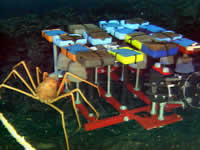| |
| |

Larval settlement arrays E and F are readied
for deployment at Cloud vent,
marker N-6. A spider crab in the foreground is checking them out.
|
|
NOAA Ship Ron Brown/ROV ROPOS
Science News
Science
Report - Friday, July 27, 2001
Bill Chadwick
Ship's position: 45 56.0'/-129 58.9'
ROPOS
dive 629 involved extensive use of the elevator mooring to get equipment
and samples down to the seafloor and back up again. Most of the elevator
cargo was larval traps and settling arrays, which are both tools used
to investigate how vent animals colonize new sites. Larval traps collect
animal larvae that is floating by in the water, whereas the setting arrays
collect larvae after they have settled out of the water, attach themselves
to a substrate, and start to grow into juveniles. Little is known about
how vent animals reproduce and spread, but they are remarkably successful,
considering that hydrothermal vent sites are ephemeral and often far apart.
Traps and arrays were recovered today from the Cloud vent area that had
been deployed for 1 week, and additional settling arrays were put down
which will be left in place for 1 to 2 years at varying distances from
the vents. With less than a week remaining in the NeMO 2001 expedition,
the schedule for the coming days is full of recoveries of short-term experiments
and deployments of long-term ones for the coming year.
|
|

